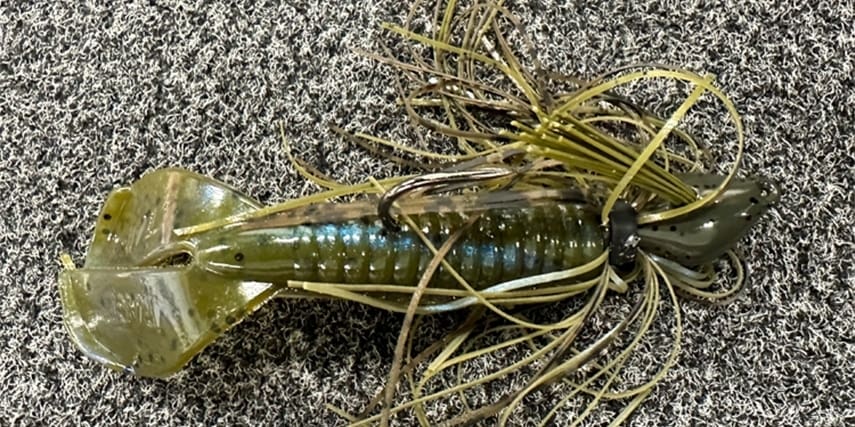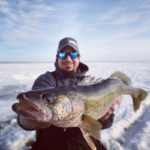If the recent 2023 Bassmaster Classic demonstrated anything, it’s that weather can play a huge part in any angler’s springtime bass plans—professional or otherwise; it’s not just the annual Classic each spring. As March and April roll around each year, serious bass-heads sign on to battle inclement conditions for the chance at stocky pre- to post-spawn bass.
Classic Re-Cap: The Tennessee River
According to Whitewater pro-staffer and recent 2023 Bassmaster Classic 7th place finisher, Jay Przekurat, tournament practice days were “absolutely brutal” with sub-zero temps, wind gusts over 30 mph, and potentially bone-piercing rain. Despite foul weather, Jay launched his Nitro every morning and battled Mother Nature in search of a river pattern that would guarantee a top-10 finish during the critical hours of bass fishing’s Super Bowl. “During practice days, the afternoons were definitely better than the mornings,” says Przekurat. “While I looked around and scouted a few spots I had marked on my Garmin units, I actually fished for hook-ups during practice,” says Przekurat. “A lot of guys just drove around, eyes glued to their graphs. It’s hard for me to do that—if I’m on the water, I just have to fish.”
Although Jay experimented with a few presentations, he resigned early to work a Strike King Structure Jig and Menace Grub combo (both in Blue Craw)—which he describes as his “go-to spring confidence bait” in the north country. “For me, shallow water and wood were key from practice all the way through Day 3 of the tournament. I’m still surprised I did as well as I did, just going out and fishing like I would anywhere,” says the 23-year-old Przekurat.

Colder Again After the Classic
While temps warmed significantly during tournament days, weather patterns since Sunday, March 26th, have been harsh throughout much of the nation. This spring, the north-central region has experienced some of the most snowfall on record, rivers are now above flood stage, and the rest of the nation has experienced generally colder temps. Weather patterns have included high winds, thunderstorms, flooding, and tornadoes that recently hit Oklahoma hard—and other damaging storm systems cycled throughout Indiana, Kansas, and Iowa—with tornadoes appearing even east of the Mississippi River.
Jay Talks Cold-Weather Gear
With a home base in Stevens Point, Wisconsin, Przekurat grew up fishing early-season bass in the cold and knows the drill. “You have to dress for warmth and comfort so you can concentrate on getting bites. Otherwise, the days can be unbearable,” says Przekurat. “The last thing you want is to be messing with what to wear. It’s like sitting in a deer stand. If you’re cold on the bow, the days are excruciating and it’s hard to keep your focus on fishing.”
To those ends, Przekurat is coming up on his first full year as a Whitewater Fishing pro staffer and design consultant, so he’s had plenty of time to test the company’s cold- and rainy-weather apparel. “I actually wore both the Whitewater Tamer fishing bib and Tamer softshell jacket under Whitewater’s premium Great Lakes jacket and rain bib during those early mornings on practice days. Luckily, though, as the hours passed—and the temps climbed during the Classic—I was able to wear just the Tamer fishing bib and Whitewater HD Buoy Fishing Hoodie, which was super comfortable and has awesome range-of-movement. You don’t even realize you’re wearing bibs,” offers Przekurat.
Przekurat says he’s run into cold-weather, springtime bass anglers who are starting to wear Whitewater’s Torque battery-powered, heated vest over the DWR-treated, water-resistant Buoy HD hoodie—all layered underneath the Tamer fishing bib without any restriction of movement or unnecessary bulk. From construction workers to late-season whitetail hunters, battery-assisted, heated apparel is starting to catch on. It’s only a matter of time before early-season bass anglers and any cold-weather anglers embrace the comfort and ease of lightweight apparel with built-in heating elements.
Speaking to the Torque heated vest, it not only features two heating pads on the chest and one on the upper back with temperature adjustments between 100 and 113 degrees, it’s lined with 80 grams of Primaloft Silver® insulation, a material the outdoor industry has used in premium products to keep people warm in cold conditions. The only predicament you’ll have with the Torque Insulated Heated Vest is do I wear it outside or inside? Outside the vest is ideal for docking or loading, as a wind-resistant, water-resistant shell or layer it underneath you’re ready for just about anything Mother Nature can throw at you.
Wrap-Up
We encourage you to get out and chase active springtime bass now. The bite can be pretty awesome. Just make sure to dress for the worst, layering for everything from sleet and wind in the mornings to warmer afternoons…

